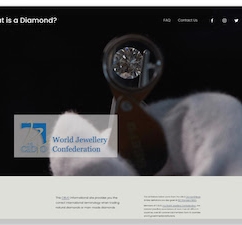Articles and News
New CIBJO Website Provides Global Diamond Terminology Guidelines But Americans Should Use FTC Terms Here | March 09, 2021 (0 comments)

Milan, Italy—CIBJO has launched a new informational website called “What is a Diamond?” to inform consumers and members of the global jewelry and gemstone industry about the precise terminology that should be used to describe both natural diamonds and lab-grown diamonds.
The new website, www.whatisadiamond.org, is an initiative of CIBJO's Diamond Commission and was built with the support of the Swiss Gemmological Institute SSEF. Using the CIBJO Diamond Blue Book as its primary reference, the new website definitions also comply with ISO Standard 18323 of the International Organisation for Standardisation. They draw a clear distinction between natural diamonds and synthetic or laboratory-grown or laboratory-created diamonds, as well qualifying what are considered natural products and what are considered products made by man.
While the Federal Trade Commission’s Guides for the Jewelry, Precious Metals, and Pewter Industries must be followed by both American jewelry companies and those doing business in the United States, it is important for those who trade internationally (both buying and selling) to understand the global standards.
Although there are few if any substantial differences between the CIBJO and FTC rules, there are subtle distinctions, says Steven Benson, CIBJO communications director.
“CIBJO Blue Book rules gives equal weight to qualifiers like synthetic and laboratory-grown, while [the] FTC clearly gives a preference to laboratory-grown,” he explains.
Sara Yood, senior counsel of the Jewelers Vigilance Committee, clarified further. “It looks like CIBJO’s definition states that the word diamond can only refer to a natural diamond. The FTC’s definition of diamond is slightly more broad, and reflects the fact that diamonds can be made in more than one process these days (i.e. allows for laboratory-grown diamonds),” she told The Centurion.
“The FTC’s inclusion of all diamond products in the definition of “diamond” does not negate the need for laboratory-grown diamond producers to clearly disclose that their products are laboratory-grown at all times,” she emphasized.
She also reminds jewelers that while the FTC no longer recommends the term “synthetic,” it does not expressly forbid its use.
But both documents reaffirm, as Yood says, that a lab-grown diamond must always be disclosed as such.
Related: A Plain-Language Guide To Changes and Important Updates In FTC Revised Jewelry Guides
The CIBJO website explains the distinctions used in the Harmonised Commodity Description and Coding System of the World Customs Organisation (WCO), and supplies concise guidelines as to the terminology that should be applied by traders of both natural diamonds and man-made diamonds.
"The purpose of the website is to be an easy-to-find and simple-to-understand reference point for all those who purchase, sell, or handle diamonds," said CIBJO president Gaetano Cavalieri. "Our goal is not to indicate what is better or more valuable, but rather to ensure that the public is able to distinguish between the different products in the marketplace. Consumer confidence, which is the bedrock of our industry, is completely dependent on people being able to make informed purchasing decisions."
The FTC Guides were revised in 2018, including changes in the guidelines for defining and describing both mined and lab-grown diamonds:
A. Use of Terms to Describe Man-Made Diamonds. The previous Guides required use of the terms “laboratory-grown”, “laboratory-created”, “[manufacturer name]-created”, or “synthetic” immediately preceding the word “diamond” to describe laboratory-grown diamonds. The revised Guides now advise marketers of man- made diamonds sharing the same optical, physical, and chemical properties as mined diamonds that they may use words or phrases other than the ones listed in the previous Guides (“laboratory-grown,” “laboratory-created,” “[manufacturer name]- created,” “synthetic”) if they clearly and conspicuously convey that the product is not a mined stone. Further, the revised Guides remove “synthetic” as a recommended descriptor, but do not prohibit the use of that term to describe laboratory-grown diamonds.
B. Use of the Term “Cultured.” The previous Guides did not specifically address use of the term “cultured” to describe laboratory-grown diamonds or other gemstones. The revised Guides advise against using the term “cultured” to describe a laboratory-grown diamond without additional descriptive or qualifying language. The accepted descriptors or qualifications are “laboratory-grown”, “laboratory-created”, “[manufacturer name]-created”, and “some other word or phrase of like meaning”. Importantly, the descriptors or qualification must be clear, prominent, and understandable.
C. Use of “Real”, “Genuine”, “Natural”, Etc. The previous Guides disallowed use of the terms “real”, “genuine”, “natural”, “precious”, “semi-precious” and similar terms to describe a manufactured or artificially-produced product. The revised Guides retain this guidance, thereby disallowing these terms to be used for laboratory-grown diamonds or any other industry product that is manufactured or produced artificially.
D. Change to Definition of Diamond. The revised Guides remove the word “natural” from the basic definition of diamond, reflecting that there is now more than one way to create a diamond. However, this does not change the requirement to describe a laboratory-grown diamond with the language described above in section II. A. The use of the unqualified term “diamond” still refers to a natural diamond.







